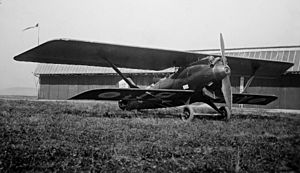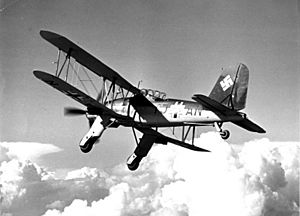Air Force of the Independent State of Croatia facts for kids
Quick facts for kids Air Force of the Independent State of Croatia |
|
|---|---|
| Zrakoplovstvo Nezavisne Države Hrvatske | |
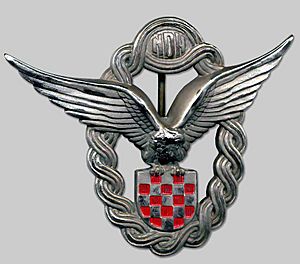
Air Force badge
|
|
| Active | 1941–1945 |
| Country | |
| Type | Air force |
| Role | Aerial warfare |
| Engagements | World War II |
| Insignia | |
| Flag (1941–1945) | 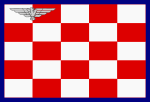 |
| Roundel and fin flash (1941–1944) |  |
| Roundel (1944–1945) |  |
| Fin flash (1944–1945) |  |
| Aircraft flown | |
| Attack | Rogožarski PVT, Rogožarski R-100, Breguet XIX |
| Bomber | Savoia-Marchetti SM.79, Dornier Do 17, Bristol Blenheim I, CANT Z.1007, Avia Fokker F.39 |
| Fighter | Ikarus IK-2, Fiat G.50, Morane-Saulnier M.S.406, Messerschmitt Bf 109, Macchi C.202 |
| Patrol | Caproni Ca.310, Caproni Ca.311, Breguet XIX, Potez XXV |
| Trainer | Potez XXV, Bücker Bü 131, Bücker Bü 133, Saiman 200, AVIA FL.3 |
| Transport | Avia Fokker F.VII, Avia Fokker F.IX, Junkers W 34, Savoia-Marchetti SM.82, Airspeed Envoy |
The Air Force of the Independent State of Croatia (Croatian: Zrakoplovstvo Nezavisne Države Hrvatske; ZNDH) was the air force of the Independent State of Croatia (NDH). This state was set up with the help of the Axis Powers during World War II. It was formed in April 1941, after the Axis invasion of Yugoslavia.
Even though it was not a huge air force, the ZNDH had about 650 aircraft between 1941 and 1945. It also had anti-aircraft and paratrooper units. The ZNDH provided air support, like fighter planes, attack planes, and transport planes, until the very end of World War II in Europe.
The ZNDH had a flying school for training pilots. It was first near Sarajevo and later in Zagreb. Its special parachute training school was in Koprivnica.
Contents
History of the Air Force
How the Air Force Started
The ZNDH began very quickly on April 19, 1941. This was just nine days after the Independent State of Croatia was announced. Its first leader was Colonel Vladimir Kren. He used to be a captain in the Royal Yugoslav Air Force.
The new air force's main goal was to find and fix aircraft, weapons, and equipment. These items had survived the fighting and were not taken by German or Italian forces. About 500 former Yugoslav air force officers and 1,600 non-commissioned officers joined the ZNDH.
After the short April War, the Germans captured over 300 Yugoslav aircraft. They decided to give many of these planes to the ZNDH. These aircraft were gathered, repaired, and stored at airfields. Croatian pilots and other air force staff were offered jobs and safety for their families. Many of them had been held in German POW camps.
Colonel Kren also started an early warning system and anti-aircraft defenses. Fuel for the ZNDH planes came from German supplies.
In May 1941, the NDH asked Germany for modern fighter planes. Instead, they received older aircraft from the former Yugoslav air force. Some captured bombers were given to Bulgaria and Romania.
During 1941, some ZNDH airmen joined the Luftwaffe on the Eastern Front. This group was called the Croatian Air Force Legion. Most of them returned to Croatia by late 1942 or early 1944. They came back to help fight against the growing Allied air threat.
The ZNDH took over airfields in Zagreb, Sarajevo, Mostar, Banja Luka, and Zemun. By June 1941, Germany started giving captured Yugoslav aircraft to the ZNDH. These planes, like the Bristol Blenheim I and Potez 25 bombers, needed repairs. Most of the 211 aircraft received by the ZNDH were fixed at the Ikarus plant in Zemun.
First Missions in 1941
By late 1941, the ZNDH had 95 aircraft. They were spread across four groups and eight squadrons. Air attacks against the Yugoslav Partisans began in June 1941. Breguet 19 and Potez 25 bombers were very useful.
The Breguets could carry up to 400 kg (880 lb) of bombs. The Potez 25s carried about half that amount. Both types also had three 7.7 mm (0.30 in) machine guns. The ZNDH eventually had 50 Breguet 19s and 45 Potez 25s. These planes were not only used to fight Partisans. They also supplied isolated army strong points.
The ZNDH planes had a red and white checkerboard symbol on their tails. This symbol, called the Šahovnica, came from the Croatian coat of arms. In January 1945, a black and white trefoil cross replaced it.
Besides the Breguet and Potez, some Zmaj Fizir FP-2 trainer planes were changed to carry bombs. These were used to bomb Partisan troops in northern Bosnia. The ZNDH lost two planes early on due to Partisan ground fire. Crews had little chance of survival if hit, as they lacked flying suits or parachutes.
Similar missions continued throughout 1941. The ZNDH supported army troops in small operations against the Partisans. These missions were mostly over eastern and western Bosnia.
By September, the ZNDH started using larger aircraft for bombing. Two bombers, an Avia Fokker F.IX and a Savoia-Marchetti SM.79, could carry 100 kg (220 lb) bombs. They were used to bomb villages and roads. However, the older Breguet 19 and Potez 25 were best for attacking Partisan groups. Even though they were old, their performance made them dangerous for the lightly armed enemy.
Partisans were hidden in villages, forests, and mountains. Slow-moving aircraft were needed to find them. Reconnaissance missions, using hand-held cameras, also gathered important information. This data helped the army, especially since they lacked radio equipment. Light aircraft were often used to connect army bases with higher command.
The ZNDH's fighter force was not well-equipped. It had 12 old planes, including four Ikarus IK-2s. Luckily, there were no enemy planes in the sky. More modern fighters arrived from 1942 onwards.
Colder weather in October and November limited flying. ZNDH planes from Sarajevo helped on the Bosnian-Serbian border. They flew daily supply missions to the surrounded garrison of Višegrad.
Growing Stronger in 1942
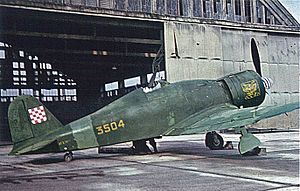
In 1942, fighting with the Partisans became more intense. The Partisans had taken control of a large area. German, Italian, and NDH forces planned big operations to stop them. Air support was very important in these plans.
In the first half of 1942, the ZNDH received new or repaired aircraft. Italy sent 10 new Caproni Ca.311 M bombers. These planes were originally ordered by Yugoslavia. The ZNDH also bought 20 AVIA FL.3 trainers and nine Fiat G.50bis fighters. The Fiat planes helped train fighter pilots on more modern aircraft.
More repaired Yugoslav planes arrived from the Ikarus plant. These included Dornier Do 17K and Bristol Blenheim Mk I bombers. Also, Rogožarski PVT and Rogožarski R-100 attack planes arrived. From Czechoslovakia, the ZNDH received seven Avia Fokker F.7 transport planes. These were quickly put into service because the ZNDH needed transport aircraft. Some were even used for regular airline flights.
The nine Fiat G.50bis fighters arrived on June 25, 1942. They were sent to Banja Luka and Zagreb to strengthen defenses. Before this, the ZNDH only had older fighters like the Avia BH-33E and Ikarus IK-2.
With more planes, the ZNDH formed new units. In January, the 1st Group was formed in Zagreb. The 2nd and 3rd Groups were formed in Sarajevo. In June, the 6th Group was formed in Banja Luka. These new groups helped cover operations in central Croatia and western Bosnia.
These new planes arrived just in time for a big German attack against the Partisans. The ZNDH was given the job of providing all air support for ground forces. In January, the ZNDH flew 121 combat missions. They flew 100 in February and 350 in March.
Besides bombing, Potez 25 and Breguet 19 planes also flew daily supply missions. They landed under fire at a small grass airstrip to deliver supplies. On March 23, a ZNDH Potez 25 was shot down by Partisans. Three days later, an Avia Fokker F.9 was damaged but returned safely. The ZNDH's efforts helped the Rogatica garrison hold out until April 17.
As the weather improved, flying increased. About 325 missions were flown in April, and 350 in May. These included combat support, scouting, and supply missions. Most missions were flown from Sarajevo, which was the strongest base. The Zagreb base attacked Partisan positions in western Slavonia and Bosnia.
The 10 new Caproni Ca.311Ms were used in attacks on Partisan areas. Blenheims and Dornier Do 17Ks were used to attack Partisan positions in Bihać, Bugojno, and Livno. The 6th Group in Banja Luka flew scouting and bombing missions. They also attacked railway stations and food supplies deep in Partisan territory. The Partisans tried to improve their anti-aircraft defense, mainly using machine guns.
In December 1942, the Croatian Air Force Legion's bomber squadron returned from the Eastern Front. They had flown over 1,500 missions. They brought nine Dornier Do 17Z bombers, which helped fight the Partisans. In late 1943, a second squadron was formed. It used Italian CANT Z.1007 and Fiat BR.20 bombers.
In 1942, the ZNDH flew about 4,800 missions. About 30% were combat missions. They lost 35 aircraft: 19 to Partisan ground fire, 12 to accidents, and four planes left their units. By the end of 1942, the ZNDH had 191 aircraft in 14 squadrons.
The first planes left the ZNDH in 1942. On May 23, a Breguet and a Potez flew to the Partisan forces. The Partisans even made fake wooden planes to trick ZNDH bombers. Two other planes, Blenheim bombers, flew to Turkey in July and October.
ZNDH Paratroopers
In January 1942, the ZNDH formed a parachute unit. It was called the 1st Light Infantry Parachute Company. It had 120 men and was based in Koprivnica. An Avia Fokker F.7 transport plane was always with the unit. The paratroopers had rifles, sub-machine guns, and light machine guns. After training, 45 paratroopers made a successful jump in Zagreb on July 6, 1943.
On November 6, 1943, Partisan forces attacked Koprivnica. The paratroopers held their base for three days before leaving. They received air support from ZNDH Dornier Do 17Ks. They also got supplies from light aircraft. However, they lost their base, 20 men, and their equipment. The ZNDH also lost a Dornier Do 17K and a Bücker Bü 131 plane.
The unit moved to Zagreb in 1944. By June 1944, it grew to four companies and was renamed the 1st Light Infantry Parachute Battalion. They defended the air base and performed guard duties in Zagreb. By January 1945, the unit was fighting the advancing Partisans. They continued fighting until May 14, 1945, after World War II officially ended.
1943: New Challenges
At the start of 1943, Axis forces controlled the skies over Yugoslavia. There were no enemy planes, so bombers could fly without fighter protection. However, this began to change. The ZNDH wanted more modern German or Italian planes. Italy refused to supply Macchi C.200 and Macchi C.202 fighters, as they needed them for their own air force.
The war situation was changing in favor of the Allies. They had landed in North Africa. The Soviet Union was pushing back German forces.
The Partisan movement in Yugoslavia grew stronger. They had over 60,000 fighters. On January 20, 1943, Germany launched an attack called Case White. It aimed to take back lost territory. Aircraft from the Luftwaffe, Italian air force, and ZNDH supported this attack. ZNDH planes from Sarajevo and Banja Luka bombed and dropped leaflets.
After Case White, the Banja Luka air base got a new 5th Group. The ZNDH now had three air bases with six Groups and 14 squadrons. In 1943, more planes arrived. Germany sent 30 repaired Dornier Do 17E bombers. Italy sent 34 Bücker Bü 131 trainers and 25 Saiman 200 light planes. These were used for training, scouting, and delivering mail and food.
The ZNDH also helped in another anti-Partisan attack called Case Black. On August 10, 1943, Partisans attacked Sarajevo's Rajlovac airfield at night. They destroyed 10 ZNDH bombers and damaged 17 other aircraft. ZNDH Command later said that spreading planes around the airfield, as ordered by Germans, made them easy targets for ground attacks.
By mid-1943, Allied planes started appearing over the Balkans. The NDH military knew this was a danger. They tried to get Messerschmitt Bf 109 fighters from Germany. Instead, they received 36 repaired French Morane-Saulnier M.S.406 fighters in October and December. Germany also supplied 25 Beneš-Mráz Beta-Minor planes for communication.
In September 1943, Vladimir Kren was replaced by Lieutenant Colonel Adalbert Rogulja. He started a major reorganization.
After Italy surrendered in September 1943, about 60 Italian aircraft were found at Mostar and Zadar airfields. The ZNDH took 33 of these planes. This included more Fiat G.50 fighters and six Fiat CR.42 biplane fighters. Some CANT Z.1007 and Fiat BR.20 bombers were also added. The Luftwaffe also gave the Croatian Air Force Legion fighter squadron about 20-25 Fiat G.50s.
The surrender of Italy also brought the threat of an Allied invasion. On September 9, ZNDH bombers were ordered to scout the Adriatic coast. On October 10, one of their Dornier Do 17Zs was shot down by eight Spitfire fighters. One Spitfire was also hit and crashed. After this, scouting missions stayed closer to the coast.
Attacks on Partisan forces continued. On October 3, seven Dornier Do 17Zs attacked a Partisan group. They caused about 60 casualties.
By the end of 1943, the ZNDH had 9,775 members and 295 aircraft. They had lost 61 planes. The best fighters the ZNDH had were 20 Morane-Saulnier M.S.406s and 10 Fiat G.50s. These planes were already old by 1940.
1944: The War Changes
After Italy surrendered, the ZNDH lost a key source of new aircraft. Allied air raids on the Balkans also became common. Luftwaffe fighter squadrons fought hard to stop American bomber fleets. The ZNDH also helped defend with its new 11th Fighter Group. This group had Morane-Saulnier M.S.406 and Fiat G.50 aircraft.
In 1944, the Croatian Air Force Legion fighter squadron returned from the Eastern Front. It was renamed Kroat. JGr 1. Its main squadron, 2./(Kroat.)JGr, sent pilots to get 12 new Macchi C.202 fighters from Italy. The Macchi C.202 was the first truly modern fighter for the ZNDH. These planes kept their Luftwaffe markings. A second training squadron was also formed. It used Fiat G.50, Macchi C.200, and Fiat CR.42 fighters. This squadron claimed about 20 Allied aircraft shot down in the summer of 1944. They also received six more Macchi C.202s and four new Macchi C.205s.
The ZNDH's older Morane-Saulnier M.S.406 and Fiat G.50 fighters tried to stop American bomber groups. They were no match for the faster Mustang and Thunderbolt fighters. They suffered heavy losses.
By the end of 1944, the Croatian Air Force Legion squadron received new German Messerschmitt Bf 109G & K fighters. A total of 21 Bf 109s were given to the ZNDH by year's end.
Allied aircraft started targeting ZNDH and Luftwaffe bases in May 1944. Before this, Axis planes could fly low without much trouble. This changed during Operation Rösselsprung. Allied fighter-bombers flew low in large numbers, gaining control of the sky. So, the ZNDH and Luftwaffe had to limit their flights to early morning and late afternoon.
In June, Germany finally sent special containers for air-dropping supplies. These were used to deliver ammunition and equipment to surrounded garrisons. The Dornier Do 17 planes were very good for these tasks. Also in June, Vladimir Kren returned as head of the ZNDH.
Toward the end of June, the ZNDH received 22 Bücker Bü 181 Bestmann aircraft. These were used for transport and liaison duties. They even carried fresh meat from Bosnia to Zagreb, where food was scarce.
Fifteen Junkers Ju 87 dive bombers were supplied to the Croatian Air Force Legion. Six of these were used against Soviet troops in late 1944.
In the second half of 1944, the war situation worsened for the Axis. Soviet, Bulgarian, and Partisan armies took over eastern Yugoslavia. Partisan forces attacked larger Axis bases in Bosnia. On September 20, they captured Banja Luka and the ZNDH's airbase. Eleven planes were left behind. Some ZNDH crews managed to escape by taking off under heavy fire. The city and airbase were later retaken by NDH and German troops.
Germany continued to supply older planes to the ZNDH. This included between nine and 12 Fieseler Fi 167 biplane torpedo bombers. These planes were good for attack missions and for carrying supplies. They could land and take off in short spaces. During one mission in October 1944, an Fi 167 was attacked by five P-51 Mustangs. The Fieseler crew, using the plane's great maneuverability, shot down one Mustang before being shot down themselves. This might have been one of the last biplane "kills" of the war.
1945: The Final Days
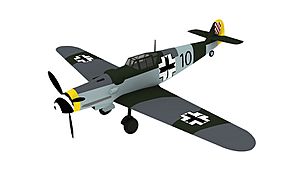
The year 1944 was very bad for the ZNDH. They lost 234 aircraft, mostly on the ground. They started 1945 with 196 planes. These included 17 Messerschmitt Bf 109Gs and 30 multi-engine bombers. However, a lack of fuel started to limit their operations.
Germany continued to deliver new aircraft in early 1945. By the end of March, 39 planes arrived. This included more Messerschmitt Bf 109Gs and 12 Dornier Do 17 bombers. In March, the ZNDH's fighter force had 23 Messerschmitt Bf 109G&Ks. With the Bf 109G, the ZNDH could finally fight Allied planes on equal terms. By April, the ZNDH still had 176 aircraft.
The ZNDH's transport planes helped evacuate Sarajevo between April 1 and 5. Dornier Do 17, Savoia Marchetti SM 79, and Junkers W34 aircraft took part.
ZNDH Dornier Do 17 bombers continued to attack when they could. On December 31, 1944, a Dornier Do 17E destroyed an RAF bomber on the ground. On February 10, 1945, a Dornier Do 17Z bombed Partisans near Daruvar, causing casualties. On March 30, four Dornier Do 17Z bombers, with four Bf 109G fighters, attacked Partisans near Gospić. On April 15, a Dornier Do 17Z and two Bf 109Gs destroyed two Partisan aircraft.
Despite these attacks, the war was clearly ending. More ZNDH personnel and aircraft left their units to join the Allies or Partisans. Two Bf 109s flew to Italy on April 16. Two more Messerschmitts flew to the Partisans on April 20. The last fighter planes were delivered on April 23, 1945. On this day, a Croatian pilot shot down two RAF P-51 Mustangs. The last attack mission was on May 6. Two old Rogožarski R-100 planes bombed a railway bridge. One was hit and crashed. The pilot was captured and killed.
That evening, as Partisans advanced on Zagreb, the ZNDH fighter group commander released his men. Some flew their planes to Italy and surrendered to Allied forces. Others flew to the Partisans. Some, including Bf 109s and a Dornier Do 17Z, sought safety in Klagenfurt, Austria.
The ZNDH's four-year history ended when airbases around Zagreb were captured on May 8, 1945. Its planes, many of them old, were found on deserted airfields. They received new markings, a red star, and became the start of the new Yugoslav Air Force.
Commanders
- Vladimir Kren (April 1941–September 1943)
- Adalbert Rogulja (September 1943 – June 1944)
- Vladimir Kren (June 1944–May 1945)
Aircraft Used by the Air Force
The Air Force of the Independent State of Croatia used a wide variety of aircraft during its existence. Many of these planes were captured from the Royal Yugoslav Air Force or supplied by Germany and Italy.
| Fighter aircraft | Number | Class | Origin |
|---|---|---|---|
| Messerschmitt Bf 109 | 50+ | Fighter | |
| Morane-Saulnier M.S.406 | 48 | Fighter | |
| Fiat G.50 | 30+ | Fighter | |
| Macchi C.202 | 18 | Fighter | |
| Macchi C.205 | 4 | Fighter | |
| Fiat CR.42 | 10+ | Fighter | |
| Messerschmitt Bf 110G-2 | 2 | Fighter | |
| Avia BH-33 | 7 | Fighter-trainer | |
| Ikarus IK-2 | 4 | Fighter | |
| Hawker Fury II | 1 | Fighter |
| Bomber aircraft | Number | Class | Origin |
|---|---|---|---|
| Dornier Do 17K | 11 | Bomber | |
| Dornier Do 17E | 30 | Bomber | |
| Dornier Do 17Z | 21 | Bomber | |
| Bristol Blenheim Mk.I | 8 | Bomber | |
| Savoia-Marchetti SM.79 | 5 | Bomber | |
| CANT Z.1007 | 10 | Bomber | |
| Fiat BR.20 | 6 | Bomber | |
| Avia Fokker F.39 | 1 | Bomber | |
| Caproni Ca.310 | 7 | Bomber/Utility | |
| Caproni Ca.311/313/314 | 16 | Bomber/Utility | |
| Junkers Ju 87 | 15 | Dive bomber |
| Transport aircraft | Number | Class | Origin |
|---|---|---|---|
| Avia Fokker F.VII | 7 | Transport | |
| Avia Fokker F.IX | 2 | Transport | |
| Junkers Ju 52 | 1 | Transport | |
| Junkers W 34 | 4 | Transport | |
| Savoia-Marchetti SM.82 | 2 | Transport | |
| Airspeed Envoy | 2 | Transport |
| Trainer and Utility aircraft | Number | Class | Origin |
|---|---|---|---|
| Breguet 19 | 50 | Reconnaissance/Utility | |
| Potez 25 | 42 | Reconnaissance/Utility | |
| Fieseler Fi 156 | 11 | Utility | |
| Fieseler Fi 167 | 8-12 | Utility | |
| de Havilland Puss Moth D.H.80 | 2 | Utility | |
| RWD-13 | 1 | Utility | |
| Beneš-Mráz Beta-Minor | 25 | Trainer/Utility | |
| Bücker Bü 181 Bestmann | 22 | Trainer/Utility | |
| Saiman 200 | 25 | Trainer | |
| Saiman 202 | 2 | Trainer/Utility | |
| AVIA FL.3 | 20 | Trainer/Utility | |
| Rogožarski SIM-XI | 1 | Trainer | |
| Rogožarski SIM-X | 1 | Trainer | |
| Rogožarski PVT | 15 | Trainer/attack | |
| Ikarus MM-2 | 1 | Fighter-trainer | |
| Rogožarski R-100 | 11 | Fighter-trainer/attack | |
| Bücker Bü 131 | 46 | Trainer/Utility | |
| Bücker Bü 133 | 10 | Trainer/Utility | |
| Zmaj Fizir FN | 20 | Trainer | |
| Zmaj Fizir FP-2 | 23 | Trainer/Utility |
Source:
Journal
The ZNDH published a weekly magazine called Hrvatska Krila (Croatian Wings).
Images for kids


